Air Mobility Plan, 2008 - The Black Vault
Air Mobility Plan, 2008 - The Black Vault
Air Mobility Plan, 2008 - The Black Vault
Create successful ePaper yourself
Turn your PDF publications into a flip-book with our unique Google optimized e-Paper software.
Executive Summary<br />
Executive Summary<br />
Task<br />
For over 10 years, <strong>Air</strong> <strong>Mobility</strong> Command (AMC) has developed and<br />
published an <strong>Air</strong> <strong>Mobility</strong> Master <strong>Plan</strong> (AMMP) every 2 years. <strong>The</strong><br />
document, and the biennial planning process necessary to create it,<br />
have guided the command’s modernization and recapitalization efforts,<br />
keeping AMC as the world’s premiere provider of Rapid Global<br />
<strong>Mobility</strong>. <strong>The</strong> <strong>2008</strong> AMMP continues that process and incorporates<br />
new roadmaps in response to the challenges presented in our changing<br />
operating environment. As the lead command for air mobility, AMC<br />
charts the direction for our MAF partners in developing and maintaining<br />
concepts, processes, and force structure. As such, our MAF partners<br />
provide input to the AMMP as AMC provides advocacy on their behalf.<br />
Capabilities-Based <strong>Plan</strong>ning (CBP) Process<br />
Following DOD and <strong>Air</strong> Force guidance, HQ AMC has developed a CBP process that ensures the<br />
MAF provides the airlift, air refueling, and air mobility support capabilities required by combatant<br />
commanders, today and into the future. This capabilities-based planning process supports the National,<br />
Joint, and <strong>Air</strong> Force visions. CBP provides consistent direction for MAF planning activities and<br />
supports Joint and Service level capabilities-based planning processes. Key to the CBP process are<br />
the command’s several Functional Capability Teams (FCT). <strong>The</strong>se teams, composed of subject matter<br />
experts from within the MAF, perform CBP-related activities to ensure the identification, prioritization,<br />
and analysis of MAF capabilities needed to support current, and future, Joint and AF military effects<br />
for each respective capability area. <strong>The</strong>y also support generation of the <strong>Air</strong> <strong>Mobility</strong> Master <strong>Plan</strong>, the<br />
development of the <strong>Air</strong> <strong>Mobility</strong> Roadmap, the Capabilities Review and Risk Assessment (CRRA)<br />
process, and the AMC POM and supporting documents. CBP is based upon a three-phased planning<br />
process conducted by FCTs. <strong>The</strong> three phases of the capability analysis process are Functional Area<br />
Analysis (FAA), Functional Needs Analysis (FNA), and Functional Solutions Analysis (FSA).<br />
FAA is the first phase in a strategy-to-capability-to-task process where the FCTs identify the functional<br />
capabilities that air mobility forces must perform today and 25 years into the future. During this phase,<br />
air mobility capabilities are identified and mapped to the air mobility mission areas, mission categories,<br />
and support processes published in the Global <strong>Mobility</strong> CONOPS, <strong>Air</strong> <strong>Mobility</strong> Master <strong>Plan</strong> and in<br />
enabling and functional concepts. <strong>The</strong> results of FAA serve as the starting point for the FNA. <strong>The</strong><br />
FNA is a task-to-need, or gap analysis process, that identifies deficiencies in the MAF’s ability to<br />
provide required capabilities today and projected capabilities in the future. During this phase, the<br />
FCTs compare actual capabilities with required capabilities, identifying and quantifying deficiencies<br />
6<br />
OCT 07
















